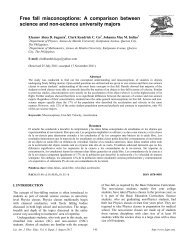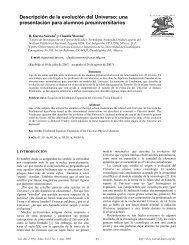Single Slit Diffraction Experiment - Latin-American Journal of ...
Single Slit Diffraction Experiment - Latin-American Journal of ...
Single Slit Diffraction Experiment - Latin-American Journal of ...
Create successful ePaper yourself
Turn your PDF publications into a flip-book with our unique Google optimized e-Paper software.
Teaching Uncertainty Principle by HybridApproach: <strong>Single</strong> <strong>Slit</strong> <strong>Diffraction</strong> <strong>Experiment</strong>Erdoğan Özdemir 1 and Mustafa Erol 21 Departmen <strong>of</strong> Physics Education, Graduate School <strong>of</strong> Natural and Applied Sciences,Balıkesir University, 10100, Balıkesir, Turkey.2 Department <strong>of</strong> Physics Education, Education Faculty <strong>of</strong> Buca, Dokuz Eylül University,35100, Buca, İzmir, Turkey.E-mail: erdoganozdemir_1979@hotmail.com(Received 9 June 2010, accepted 2 September 2010)AbstractA hybrid teaching model, which contains 44% peer tutoring, 26% group and class discussion, 26% problem solvingwithin group, 4% demonstration and finally some homework activities that contain problem construction and problemsolving activities, is developed and administered to teach the uncertainty principle. Pre-test and post-test controlgrouped experimental model is employed in the research with a sampling <strong>of</strong> 35 undergraduate students. Data <strong>of</strong> theresearch was collected by means <strong>of</strong> a “<strong>Single</strong> <strong>Slit</strong> <strong>Diffraction</strong> <strong>Experiment</strong> Classical Exam” which is made up <strong>of</strong> 8separate questions and a “Semi Structured Interview Form”. The content is formed through the single <strong>Slit</strong> <strong>Diffraction</strong><strong>Experiment</strong> in order to investigate the Uncertainty Principle especially the limits <strong>of</strong> classical and quantum mechanicalregions. The data were analyzed by means <strong>of</strong> Mann Whitney U Test and Wilcoxon Signed Rank Test and additionallyqualitative analyses techniques are employed. The overall results clearly indicate that the hybrid approach is moreeffective than the conventional technique on academic achievement, retention and on building true studentconceptions.Keywords: Physics Education, Instructing Quantum Physics, Uncertainty Principle, Hybrid Teaching Approach,<strong>Single</strong> <strong>Slit</strong> <strong>Diffraction</strong>.ResumenSe muestra un modelo de enseñanza híbrido, que contiene 44% tutorías entre pares, el 26% discusión en grupo yclase, el 26% de resolución de problemas dentro del grupo, el 4% de demostración y, finalmente, algunas queactividades de tareas que contienen construcción de problemas y actividades de resolución de problemas, estádesarrollado y administrado para enseñar los Principio de Incertidumbre. El modelo experimental de pre-test y posttestde control agrupados se emplea en la investigación con una muestra de 35 estudiantes de pregrado. Los datos dela investigación fueron obtenidos a través de un "Examen del experimento clásico de una rejilla de Difracción", que secompone de 8 preguntas por separado y de un "Formato de Entrevista Semi Estructurada". El contenido está formadopor el experimento de una rejilla de difracción con el fin de investigar el principio de incertidumbre, especialmentelos límites de las regiones de la mecánica clásica y cuántica. Los datos se analizaron por medio del Test U de MannWhitney y del Test de Rango Firmado de Wilcoxon, además, se emplean las técnicas de análisis cualitativos. Losresultados globales indican claramente que el enfoque híbrido es más eficaz que la técnica convencional en los logrosacadémicos, la retención y en la creación de concepciones verdaderas del estudiante.Palabras claves: Educación en Física, Instrucción de Física Cuántica, Principio de Incertidumbre, método deenseñanza híbrida, Difracción de una rendija.PACS: 01.40-d, 01.40.Fk, 01.40.Ha ISSN 1870-9095I. INTRODUCTIONunderstand quantum physical concepts due to mainlyfollowing points: 1) Students being thought classicalIn spite <strong>of</strong> being a very well-built theory, due to being physics, based on the causality and determinism, experiencebased on probabilities and uncertainties, quantum theory is great difficulties to understand quantum physical principlescriticized by many scientists [1]. The principles <strong>of</strong> quantum based mainly on the uncertainty and probability [9]. 2)theory, which contain clear controversies with daily Quantum physics are considered to be mysteries and absurdexperiences and human observant, are very demanding and hence students believe that it is not fully understood. 3)difficult to internalize and understand [2, 3, 4, 5, 6, 7, 8, 9, Quantum physics is full <strong>of</strong> very complicated mathematical10]. Majority <strong>of</strong> the students have convinced problems to equations. 4) Students are insensible towards quantumphysical lawsLat. Am. J. Phys. Educ. Vol. 4, No. 3, Sept. 2010 473 http://www.lajpe.org
Erdoğan Özdemir and Mustafa ErolIn recent years, studies on the teaching <strong>of</strong> quantumphysics are greatly increased. These studies can becategorized under two sub-titles. Firstly, “misconceptionsand teaching difficulties” and secondly “experimentalstudies on more effective learning <strong>of</strong> quantum physics”.Searching fundamental misconceptions on teachingquantum physics highlights the following studies. Bilal andErol [2] expressed that students do not comprehend therelation between wave functions and the concepts <strong>of</strong>probability. Steinberg et al. [7] searched the possibleimpact <strong>of</strong> classical physics upon student learning <strong>of</strong>quantum physical concepts and found out that students donot have scientifically acceptable models concerning waveconcepts. Mashhadi and Woolnough [8] investigated howstudents visualize electron and photon in their mind. Theysuggest that the students have a wide range <strong>of</strong> non-scientificrepresentations in their minds. Olsen [4] propounded thatstudents do not understand the structure <strong>of</strong> electron andphoton. It is also expressed that underlying cause <strong>of</strong> theseconcepts is classical physical concepts. Difficulties onteaching quantum physical concepts require identification<strong>of</strong> factors that complicate quantum physics. Ambrose et al.[11] resolute some models structured by the students on thestructure <strong>of</strong> light and they also found out that students areunable to develop scientifically logical models aboutstructure <strong>of</strong> light. Müller and Wiesner [6] searched how tolearn the concept <strong>of</strong> atom, spatial confinement, anduncertainty principle and emphasized some learningdifficulties <strong>of</strong> quantum mechanics. Bethge and Niedderer[12] expressed that students accepted physical structure <strong>of</strong>particles and the relation with uncertainty principle;however they insistently carry some thoughts from classicalphysics. Aylward [13] articulated that the principle <strong>of</strong>uncertainty caused by the technological deficiency, itmeans <strong>of</strong> absolute error and it is about single particlemeasurement. The effort <strong>of</strong> explaining quantum physicalconcepts by means <strong>of</strong> the classical concepts causes certainmisconceptions especially on understanding the uncertaintyprinciple [14]. The misconceptions can principally besummarized as follows: 1) Uncertainty principle means thatthe position and momentum <strong>of</strong> a single particle can notpossibly be measured by any means [13]. 2) Uncertaintyprinciple originates from the measurement faults. 3)Uncertainty principle also means that performedmeasurement varies the actual measured value. 4) Theuncertainty <strong>of</strong> the position is actually equal to the width <strong>of</strong>the confinement. 5) Position uncertainty means the spatialinterval <strong>of</strong> the position. 6) Uncertainty is caused by thetechnological inefficiency. 7) Uncertainty caused by themeasurement mistakes. 8) Uncertainty is caused by the veryfast motion <strong>of</strong> the microscopic particles. 9) x and P x arethe differences between the two measured values <strong>of</strong> theposition and momentum, respectively. 10) x is the meanvalue <strong>of</strong> the displacement at the direction <strong>of</strong> x. 11) x andP x are the mistakes <strong>of</strong> the measurements on the positionand momentum [15].Steingberg et al. [7] investigated the effects <strong>of</strong> classicalconcepts on learning quantum mechanics and concludedthat lack <strong>of</strong> classical physics knowledge causesmisunderstanding <strong>of</strong> quantum physical concepts. Ireson [5]suggested that quantum physics ought to be thoughtindependently from classical physics. Abhang [9]emphasized learning difficulties <strong>of</strong> quantum mechanicalconcepts based on uncertainty and probability withconvincing concepts from classical physics. Additionally, itis more beneficial to focus on the logical link between theconcepts. Quantum physics, it is ought to be to express limit<strong>of</strong> classical physics, to apply thought experiment and instead<strong>of</strong> separately to explain the concept, to specify logicalrelationship between concepts.In the literature a number <strong>of</strong> studies deal with thedetermination <strong>of</strong> misconceptions and getting rid <strong>of</strong> learningdifficulties. Müller and Wiesner [16] developed acurriculum enriched with some experiments and found outthat the students learned quantum physical conceptscorrectly. Niedderer et al. [17] developed some materials onteaching quantum physics focusing on physical dimension<strong>of</strong> the concepts rather than mathematical and also containingsome specific simulations. Bergström et al. [18] explainwave structure <strong>of</strong> electron by electron diffractionexperiments and the structure <strong>of</strong> quantum physical systemby using classical wave experiments. Johanson and Milstead[19] put forward that an effective teaching <strong>of</strong> uncertaintyprinciple can be achieved by performing the single slitdiffraction experiment. Robblee et al. [20] explored thatusing computer technology on teaching quantum physics.Rebello and Zollman [21] administered their visualcomputerized materials to undergraduate students and findout those student misconceptions is substantially reduced.Evaluation <strong>of</strong> the overall literature indicates that thefundamental gap on teaching quantum physics is more lessto perform specific experimental research on effective andconsistent conceptual learning. This study specificallyconcentrates on bridging the gap. The present workspecifically focuses on the uncertainty principle which isone <strong>of</strong> the most fundamental concepts <strong>of</strong> quantum physicsand also considered as one <strong>of</strong> the most confusing concepts.We designed a basic single slit experiment and performedthe experiment by varying the slit width and demonstratedclear shift from classical limits to quantum mechanicallimits. This shift allowed us understanding correspondenceprinciple and limitations <strong>of</strong> classical physics. So, it can behelpful to clearly understanding <strong>of</strong> Heisenberg UncertaintyPrinciple [19]. And also to support students’ attention,cooperation, sharing ideas, problem solving skills andindividual working, we performed hybrid approach consists<strong>of</strong> 44% peer tutoring, 26% group and class discussion, 26%problem solving within group, 4% demonstration and finallyhomework containing problem construction and solving.II. RESEARCH QUESTIONSAre there any significant differences on academicachievement, retention level and misconceptions concerninginstruction <strong>of</strong> uncertainty principle between theexperimental group students trained by hybrid teachingLat. Am. J. Phys. Educ. Vol. 4, No. 3, Sept. 2010 474 http://www.lajpe.org
approach and the control group students trained byconventional methods?III. METHODA. Research ModelPre-test and post-test control grouped experimental modelis employed in the research. Independent variables <strong>of</strong> theresearch consist <strong>of</strong> hybrid model and conventional teachingmethod. Dependent variables <strong>of</strong> the study are academicachievement, level <strong>of</strong> retention and finally students’misconceptions and learning difficulties.B. Sampling <strong>of</strong> the StudyThe sampling <strong>of</strong> the research comprised <strong>of</strong> overall 35undergraduate students who all attend third grade <strong>of</strong> physicseducation department at a state university in İzmir. Thestudents were randomly divided into two groups. The firstgroup is called experimental group and comprised <strong>of</strong> 14female and 3 male students. The second group is calledcontrol group comprised <strong>of</strong> 13 female and 5 male students.In order to determine the pre knowledge and theequivalence <strong>of</strong> the groups, the classical exam test is initiallyadministered two the both groups and the result is presentedin the table I.TABLE I. Comparison <strong>of</strong> the pre measurements <strong>of</strong> theexperimental and control groups.Group N Tier Mean Tier Sum z p<strong>Experiment</strong>al 17 17,50 297,50144,5 0,782 *Control 18 18,47 332,50The table I clearly confirms that there is no significantdifference concerning pre measurement points <strong>of</strong> theexperimental and control group students. It is also clear thatmean <strong>of</strong> the control group students is slightly higher thanmean <strong>of</strong> the experimental group students.C. Data Collection ToolsTeaching Uncertainty Principle by Hybrid Approach: <strong>Single</strong> <strong>Slit</strong> <strong>Diffraction</strong> <strong>Experiment</strong>the topic <strong>of</strong> single slit diffraction. The draft copy <strong>of</strong> theclassical exam was criticized by two experts <strong>of</strong> the field andthe final form is reached by considering suggestions <strong>of</strong> theexperts. The students were given 20 minutes to answer andthe evaluation <strong>of</strong> the outcomes was carried out by means <strong>of</strong>a pre developed Classical Exam Rubric. During thedevelopment session, the scale was administered to 26undergraduate students who all attended quantum physicscourse and the scale was evaluated twice within two mouths.The scale has a Pearson correlation coefficient <strong>of</strong> 0, 86.II- Semi Structured Interview formSemi structured interview form was developed byconsidering the answers <strong>of</strong> the students to the classical examquestions. The interview focused on the physical meaning <strong>of</strong>the uncertainty principle.IV. TEACHING SEQUENCEA. Content and OrderThe wave property <strong>of</strong> the particles ought to be understoodvery deeply in order to understand the uncertainty principle<strong>of</strong> the quantum physics [3, 7, 15]. One <strong>of</strong> the main factorsthat effect the instruction <strong>of</strong> the wave property <strong>of</strong> theparticles is the presence <strong>of</strong> the wave particle duality [4].This concept blocks the learning channels <strong>of</strong> the studentsrather than to easy the instruction mechanism. Its is clearthat the students have learning difficulties because they tryto understand the quantum physical concepts by simplyconsidering the classical concepts [5, 13, 22]. In order toprevent that sort <strong>of</strong> misconceptions, statistical interpretation<strong>of</strong> the quantum physics is placed within the program.Additionally, the thought experiment designed byHeisenberg is widely employed throughout the applications.The experiment explains the uncertainty <strong>of</strong> a single electron,however it would cause that the uncertainty is actually aboutonly single electron. The content is therefore structured onespecially single slit diffraction experiment rather than thethought experiment <strong>of</strong> the Heisenberg such that the studentscan compare the classical and quantum limits <strong>of</strong> theuncertainty principle. The content order is thereforestructured as follows: Uncertainty concerning single slitdiffraction experiment: a) single slit diffraction experimentat classical limits b) single slit diffraction experiment <strong>of</strong> thequantum mechanical particles.In order to explore potential answers <strong>of</strong> the researchproblem, two separate data collection tools are employed.These are “<strong>Single</strong> <strong>Slit</strong> <strong>Diffraction</strong> <strong>Experiment</strong> ClassicalExam ” and “Semi-Structured Interview Form”.I- <strong>Single</strong> <strong>Slit</strong> <strong>Diffraction</strong> <strong>Experiment</strong> Classical ExamTo investigate the relation between the independent variablethat is teaching method and dependent variables which areacademic achievement and retention levels, a ClassicalExam is prepared. The exam consists <strong>of</strong> eight questions onB. Applied Techniques and Instructional StudiesFollowing the content, a hybrid approach model isdeveloped by consideration the structure andmisconceptions on the subject. The stages, techniques,durations and percentages <strong>of</strong> the model is given by the tableII.Lat. Am. J. Phys. Educ. Vol. 4, No. 3, Sept. 2010 475 http://www.lajpe.org
Erdoğan Özdemir and Mustafa ErolTABLE II. Hybrid teaching model.Hybrid teaching modelStages Instruction Duration(min.) Percentage(%)TechniquePreparation Demonstration 5 4Instruction Peer60 44instructionInclassroomDiscussion 35 26activityProblemsolving withingroup35 26OutclassroomactivityIndividualproblemsolving andproblemdevelopment- -The stages <strong>of</strong> the developed hybrid approach can briefly besummarized as follows:Preparation: It’s crucial to use visual methods to succeedthe teaching approach [23]. Visual techniques and methodsease the learning and also motivate the students in a betterway [24]. Demonstration technique is therefore used at thepreparation stage.Instruction: It is proposed to improve the students’ socialinteraction abilities and also by entering each others“approximate progress field” it is aimed to determine theneeds <strong>of</strong> the students and to help and support them inaccordance [36]. In order to realize peer instruction, one <strong>of</strong>the active learning techniques, is employed [26, 27]. Thestudents are divided into groups and the group studentswere made to study the content within the group. Thefeedbacks and corrections are given simultaneously [28].In-classroom activity: The stage is made up <strong>of</strong> twostages, namely discussion and problem solving within thegroup. In the first stage, the students having efficientbackground prepares some problems by consideringcommon misconception and the developed problems arediscussed by the students within the group. The researchermaintains the frame <strong>of</strong> discussion by simply moving aroundcontinuously. A classroom discussion is realized finally toend the first session. By doing so questionnaire, analyzeand a better learning is aimed. In the second stage it’saimed to teach the mathematical bases <strong>of</strong> the concepts in adeeper manner [29]. To do so the students are asked tosolve the problems within the group and a selected studentis asked to solve the problem at the board.Out-classroom activity: At this stage the students aregiven some home works to maintain their personaldevelopments [30]. The home works contain problemsolving and problem development stages. The activities areevaluated within the week and feedbacks are given to thestudents.VI. FINDINGSA. Classical Exam FindingsIn order to investigate the effect <strong>of</strong> hybrid approach teachingon academic achievement within the experimental groupstudents the classical exam was administered before andafter the teaching season as pre and post measurements. Dueto be working on very small sampling sizes, WilcoxonSigned Rank Test and Mann-Whitney U Test were employedduring the evaluation <strong>of</strong> the data [24].TABLE III. Comparison <strong>of</strong> Pre and Post Measurements <strong>of</strong> the<strong>Experiment</strong>al Group Students.Pos Test- PreTestNegative TierPositive TierEqualLat. Am. J. Phys. Educ. Vol. 4, No. 3, Sept. 2010 476 http://www.lajpe.orgN017-TierMean0,009,50*significant difference if, p
the classical exam <strong>of</strong> the control group students. It is alsoclearly seen from the tier sum points that the difference is infavor <strong>of</strong> the positive rank that means in favor <strong>of</strong> the posttest. If we investigate classical exam pre and post answers<strong>of</strong> the control group students, the following points comeforward.Investigation <strong>of</strong> the student’s answers to the classicalexam questions highlights a few points: firstly 37% <strong>of</strong> thecontrol group students acknowledged that the uncertaintyprinciple is obeyed by classical particles concerning singleslit diffraction experiments. Following the conventionalteaching, 16% <strong>of</strong> the students consistently protects theirview. Additionally, 68% <strong>of</strong> the students expressed that aGaussian distribution occurs on the screen for the classicalparticles. However, 21% <strong>of</strong> the control group studentsexpressed that classical particles obey uncertainty principleconcerning post test answers. Secondly, only 37% <strong>of</strong> thecontrol group students expressed that the interferencepattern form even the slit gap is much larger than the deBroglie wave length <strong>of</strong> the quantum mechanical particles.However 47% <strong>of</strong> the students believe that if slit gap ismuch larger than the wave length <strong>of</strong> the particle, a Gaussiandistribution is expected to occur just like classicalsituations. Some 42% <strong>of</strong> the students think that if the slitwidth and the wave length is comparable then interferencepattern is expected to occur on the screen.Teaching Uncertainty Principle by Hybrid Approach: <strong>Single</strong> <strong>Slit</strong> <strong>Diffraction</strong> <strong>Experiment</strong>distribution occurs on the screen. These students the thinkthat if the slit width is comparable with the de Broglie wavelength <strong>of</strong> the particles then the uncertainty principlegradually becomes important and as the width gets narrowerthe uncertainty <strong>of</strong> the momentum becomes larger. Some47% <strong>of</strong> the control group students state that if the slit widthis much larger than the wave length a Gaussian distributionoccurs, however 42% <strong>of</strong> the control group students state thatin the case <strong>of</strong> comparable width and de Broglie wave lengthan interference pattern is expected to occur.The table VI indicates a insignificant difference betweenpost and delayed measurements <strong>of</strong> the experimental groupstudents concerning the Classical Exam. Consideringadditionally the difference, the difference is in favor <strong>of</strong> thenegative tier which means in favor <strong>of</strong> the post test.TABLE VI. Comparison <strong>of</strong> the post and delayed measurements <strong>of</strong>the experimental group students.Post-DelayedTestsNegative tierPositive tierEqualN1034TierMean7,007,00*insignificant difference , if p >0,05.TierSumz p70,0021,00 -1,717 0,086TABLE V. Comparison <strong>of</strong> the post measurements <strong>of</strong> theexperimental and control group students.Groups N Tier Mean Tier Sum z p<strong>Experiment</strong>al 17 23,71 403,0056,000 0,001Control 18 12,61 227,00* significant difference if, p 0,05.The table V indicates a meaningful difference betweenexperimental and control group students’ post test resultsconcerning the Classical Exam in favor <strong>of</strong> the experimental.Additionally considering tier means, it is also clear that themean <strong>of</strong> the experimental group is much higher than themean <strong>of</strong> the control group students.Comparison <strong>of</strong> the experimental and control groupstudents’ post measurements concerning the classical exam,highlights the following points: 83% <strong>of</strong> the experimentalgroup students after the actual training expressed that theclassical particles experiencing the single slit diffractionform a Gaussian distribution and only 47% <strong>of</strong> theexperimental group students assumed that the uncertaintyprinciple is meaningless for the classical particles. Some68% <strong>of</strong> the control group students believe that the classicalparticles obey the Gaussian distribution however 21% <strong>of</strong>the control group students expressed that the uncertaintyprinciple gives meaningful results for the classical particles.Some 77% <strong>of</strong> the experimental group students affirmed thatif the slit width is much larger than the de Broglie wavelength <strong>of</strong> the quantum physical particles than the resultswould be very close to the classical case and a GaussianThe table VII indicates a insignificant difference betweenpost and delayed measurements <strong>of</strong> the control groupstudents’ regarding the Classical Exam. Consideringadditionally the difference, the difference is in favor <strong>of</strong> thenegative tier which means in favor <strong>of</strong> the post test results.TABLE VIII. Comparison <strong>of</strong> the control and experimental groups’delayed measurements.Groups N Tier Mean Tier Sum z p<strong>Experiment</strong>al 17 22,18 377,0082,00 0,017Control 18 14,06 253,00*insignificant difference (if p >0,05)The table VIII indicates a significant difference between thecontrol and experimental group students delayedmeasurements relating to the Classical Exam. Consideringadditionally the tier means, the mean <strong>of</strong> the experimentalgroup students is considerably larger then the control groupstudents.Lat. Am. J. Phys. Educ. Vol. 4, No. 3, Sept. 2010 477 http://www.lajpe.org
Erdoğan Özdemir and Mustafa ErolB. InterviewThe classical exam findings are also supported by somestudent interviews. The interviews <strong>of</strong> the research werecarried out just before and after the actual experimentalsequence. The data <strong>of</strong> is evaluated by means <strong>of</strong> the contentanalysis. The content analysis was realized in order to reachthe specific concepts and relations that could explain theactual data. The genuine activity <strong>of</strong> the content analysis wasto group similar concepts and themes and present them in amost understandable manner. The interview focused on thephysical meaning <strong>of</strong> the uncertainty principle and thefundamental results are presented below.TABLE IX. The answers and percentages <strong>of</strong> the experimental group and control group students before and after the actual schooling session.<strong>Experiment</strong>al group students’ views before the applicationSharing viewsAnswer Type Student View frequency %Student 3: “yes, we use the multi measurementsUncertainty principle deals with position and momentum<strong>of</strong> position and momentum <strong>of</strong> a single 4 66uncertainty <strong>of</strong> a single electron.electron.”<strong>Experiment</strong>al group student’ views after the applicationUncertainty principle deals with position and momentumuncertainty <strong>of</strong> many identical electrons.Student 3: “we use the statistical values <strong>of</strong> themany measurements performed for differentidentical electrons.”5 83Control group students’ views before the applicationSharing viewsAnswer Type Student View frequency %Uncertainty principle deals with position and momentumuncertainty <strong>of</strong> a single electron measured many times.Control group students’ views after the applicationUncertainty is obtained from the values <strong>of</strong> manymeasurements performed on a single electron.Student 10: “Uncertainty is the average <strong>of</strong> themany simultaneous measurements <strong>of</strong> positionand momentum <strong>of</strong> a single electron.”Student 8: “we obtain the uncertainty bymeasuring the position and momentum <strong>of</strong> asingle electron at different times.”2 503 75VI. DISCUSSION AND IMPLICATIONSThe present work designed to explore the effect <strong>of</strong> a hybridteaching design on academic achievement regarding thesingle slit diffraction experiment, specifically designed toinvestigate the quantum mechanical and classical limits. It isfinally detected that the hybrid teaching method influencedthe academic achievement and also the retention levelsubstantially in comparison with the conventional techniques.The overall results are in a good agreement with the previousfindings; similarly employ a hybrid teaching approach withsome active teaching techniques [31, 32]. The success ispossibly due to the content <strong>of</strong> the hybrid teaching method inthe sense that a single slit diffraction experiment realized inthe classroom by varying the slit width in order to show theclassical and quantum limits [33].The evaluation <strong>of</strong> the classical exam papers indicate thatthe experimental group students heavily think with respect tothe control group students that the classical particles obeyGaussian distribution during the single slit diffractionexperiment however the quantum mechanical particles do notobey diffraction pattern at any case. The other aim <strong>of</strong> thepresent work was to determine the student misconceptionsand learning difficulties regarding the uncertainty principleand explore possible ways to eliminate them. The mostpronouncing detected misconception before the actualtraining for both experimental and control group students wasthat they mostly believe that the uncertainty relates to themovement <strong>of</strong> only a single electron. A very similar result wasdetermined by [13]. The students interpret the uncertaintyjust like for the classical measurements, in other words, theposition and momentum <strong>of</strong> a single electron is measuredmany times and then the standard deviation is calculated.To our view, the detected misconceptions and learningdifficulties originates from the student trend <strong>of</strong>interconnecting the novel quantum physical concepts withthe previous classical concepts [7]. The majority <strong>of</strong> thestudents think that the quantum physical particles havedefinite position and momentum beforehand themeasurement just like the classical cases [8, 7, 15]. Thefundamental problem here is that the students interrelate thequantum physical concepts with the previous onesmistakenly and their daily experiences and intuitive viewsmislead them eventually creating the problem.Supporting the instruction session by means <strong>of</strong> somevisualized materials and tools, thought experiments andactual physical experiments certainly helps the studentunderstanding and internalizing the difficult quantumphysical concepts [34, 35] intuitive and controversialstructure <strong>of</strong> the quantum physical concepts increase theactual need to designing an effective and understandableinstruction materialsThe other point is that the trend <strong>of</strong> linking quantumphysical concepts with the classical concepts seems to becreating challenging misconceptions and learningdifficulties. It is therefore important to especially eliminatethis trend by designing the courses in a revolutionarymanner.The overall conclusion <strong>of</strong> the research is that the hybridteaching method meaningfully increases the studentLat. Am. J. Phys. Educ. Vol. 4, No. 3, Sept. 2010 478 http://www.lajpe.org
understanding and internalizing <strong>of</strong> the quantum physicalconcepts. Hence, the research can be extended to explorethe influence <strong>of</strong> different techniques and proportions toeventually reach the perfect hybrid teaching approach.REFERENCES[1] Ho<strong>of</strong>t, G., In Search <strong>of</strong> the ultimate building blocks(Cambridge University Press, Cambridge, 1997).[2] Erol, M., Philosophy and instruction <strong>of</strong> quantumphysics (QP), Balkan Physics Letters, Special Issue, 16-24(2008).[3] Bilal, E. and Erol, M., Student understanding <strong>of</strong> somequantum physical concepts: Wave function, Schrödinger’swave equation and wave-particle duality, <strong>American</strong>Institute <strong>of</strong> Physics 899, 499 (2007).[4] Olsen, R. V.,, visited in June-3-2007.[5] Ireson, G., A multivariate analysis <strong>of</strong> undergraduatephysics students’ conceptions <strong>of</strong> quantum phenomena,European <strong>Journal</strong> <strong>of</strong> Physics 20, 193-199 (1999).[6] Müller, R. and Wiesner, H., Students’ conceptions <strong>of</strong>quantum physics, The annual meeting <strong>of</strong> NationalAssociation for Research in Science Teaching. Boston,Massachusetts, (1999).[7] Steinberg, R., Wittmann, M. C., Bao, L. and Redish, E.F., The influence <strong>of</strong> student understanding <strong>of</strong> classicalphysics when learning quantum mechanics, The annualmeeting <strong>of</strong> National Association for Research in ScienceTeaching. Boston, Massachusetts, (1999).[8] Mashhadi, A. and Woolnough, B., Insights into students’understanding <strong>of</strong> quantum physics: Visualizing quantumentities, European <strong>Journal</strong> <strong>of</strong> Physics 20, 511-516 (1999).[9] Abhang, R. Y., Making introductory quantum physicsunderstandable and interesting, Resonance 10, 63-73(2005).[10] Pospiech, G., Uncertainty and complementarily: Theheart <strong>of</strong> quantum physics, Physics Education 35, 393–399(2000).[11] Ambrose, B. S., Heron, P., Vokos, S. and McDermott,L. C., Student understanding <strong>of</strong> light as an EM wave:Relating the formalism to physical phenomena, <strong>American</strong><strong>Journal</strong> <strong>of</strong> Physics 67, 891- 898 (1999).[12] Bethge, T. and Niedderer, H., ,visitedin 10-May-2006.[13] Aylward, K., , visitedin 10-May-2006.[14] Kopman, L., Kaper, W. H. and Ellermeijer, A. L.,,visited in 4-6 July2005.[15] Özdemir, E. and Erol, M., Student misconceptionsrelating wave packet and uncertainty principle in quantumphysics, Balkan Physics Letters, Special Issue, 641-635(2008).Teaching Uncertainty Principle by Hybrid Approach: <strong>Single</strong> <strong>Slit</strong> <strong>Diffraction</strong> <strong>Experiment</strong>[16] Müller, R. and Wiesner, H., Teaching quantummechanics on an introductory level, <strong>American</strong> <strong>Journal</strong> <strong>of</strong>Physics 70, 200-209 (2002).[17] Niedderer, H. and Deylitz, S., Evaluation <strong>of</strong> a newapproach in quantum atomic physics in high school, Theannual meeting <strong>of</strong> National Association for Research inScience Teaching, Boston, Massachusetts, (1999).[18] Bergström, L., Johanson, K. E. and Nilsson, C. H., Thephysics <strong>of</strong> Copenhagen for students and the general public,Physics Education, Nuclear Physics, 388-393 (2001).[19] Johanson, K. E. and Milstead, D., Uncertainty in theclassroom-teaching quantum physics, Physics Education43, 173-179 (2008).[20] Robblee, K. M., Garik, P., Abegg, G. and Zollman, D.Using computer visualization s<strong>of</strong>tware to teach quantumscience: the impact on pedagogical content knowledge. Theannual meeting <strong>of</strong> National Association for Research inScience Teaching, Boston, Massachusetts, (1999).[21] Zollman, D., Rebello, N. S. and Hogg, K., Quantummechanics for everyone: hands-on activities integrated withtechnology, <strong>American</strong> <strong>Journal</strong> <strong>of</strong> Physics 70, 252-260(2001).[22] Özdemir, E., Kuantum Fiziği Belirsizlik İlkesi: HibritYaklaşımla Öğretiminin Akademik Başarıya etkisi, YüksekLisans Tezi, Eğitim Bilimleri Enstitüsü, Dokuz EylülÜniversitesi, (2008).[23] Karamustafaoğlu, O., Fen ve teknoloji öğretmenlerininöğretim materyallerini kullanma düzeyleri: Amasya iliörneği, A.Ü. Bayburt Eğitim Fakültesi Dergisi I, 90–101(2006).[24] Çepni, S., Ayas, A., Johnson, D.,ve Turgut, F., Fiziköğretimi (YÖK/Dünya Bankası Milli Eğitimi GeliştirmeProjesi Hizmet Öncesi Öğretmen Eğitimi, Ankara, 1997).[25] Açıkgöz, K. Ü., Aktif Öğrenme (Eğitim DünyasıYayınları, İzmir, 2003).[26] Eggen, P. and Kauchak, D., Learning and teaching:research based methods, (Allyn and Bacon, Boston, 1998).[27] Shunk, D., Learning theories: An educationalperspective, (Prentice Hall, Ohio, 2000).[28] Sönmez, V. Program Geliştirmede Öğretmen El Kitabı,(Anı Yayıncılık, Ankara, 2004).[29] Akarsu, B., Students’ misconceptual understanding <strong>of</strong>quantum physics in college level classroom environments,Ph.D. dissertation, Bloomington: Indiana University,(2007).[30] Yücel, A. S., Ortaöğretim düzeyindeki öğrencilerinkimya derslerinde verilen ev ödevlerine karşı tutumlarınınincelenmesi, Gazi Eğitim Fakültesi Dergisi 24, 147-159(2004).[31] Ramsier, R. D., A hybrid approach to active learning,Physics Education 36, 124-128 (2001).[32] Bilal, E. and Erol, M., Influence <strong>of</strong> hybrid teachingapproach on attitude and success concerning electrostatics,<strong>Journal</strong> <strong>of</strong> Science Education 6, 63-74 (2009).[33] Özdemir E. and Erol M., <strong>Single</strong> slit diffractionexperiment: Investigating classical and quantummechanical limits, Balkan Physics Letters 15, 1-7 (2009).[34] Rebello, N. S. and Zollman, D. Conceptualunderstanding <strong>of</strong> quantum mechanics after using hands-onLat. Am. J. Phys. Educ. Vol. 4, No. 3, Sept. 2010 479 http://www.lajpe.org
Erdoğan Özdemir and Mustafa Eroland visualization instruction materials, (NationalAssociation for Research in Science Teaching, Boston,Massachusetts, 1999).[35] Redish, E. F., Steinberg, R. N. and Wittmann, C.,


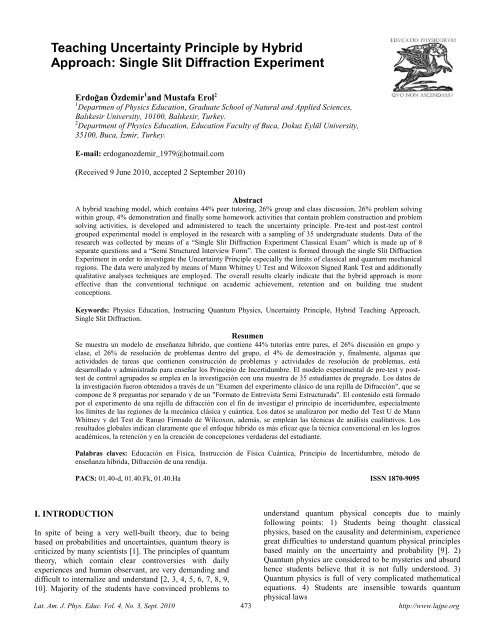
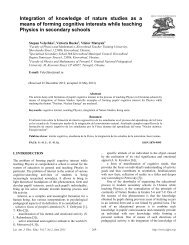
![Diversas formas de visualizar estados en un sistema cuántico [PDF]](https://img.yumpu.com/51151303/1/190x245/diversas-formas-de-visualizar-estados-en-un-sistema-cuantico-pdf.jpg?quality=85)

![Precession and nutation visualized [PDF]](https://img.yumpu.com/50786044/1/190x245/precession-and-nutation-visualized-pdf.jpg?quality=85)
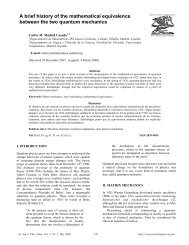
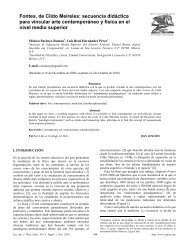
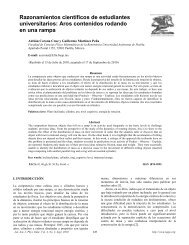

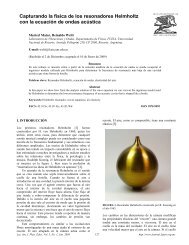
![Index [PDF] - Latin-American Journal of Physics Education](https://img.yumpu.com/47984121/1/190x245/index-pdf-latin-american-journal-of-physics-education.jpg?quality=85)
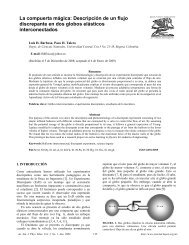
![Flujo de agua en botellas como experimento didáctico [PDF]](https://img.yumpu.com/43536300/1/190x245/flujo-de-agua-en-botellas-como-experimento-didactico-pdf.jpg?quality=85)
